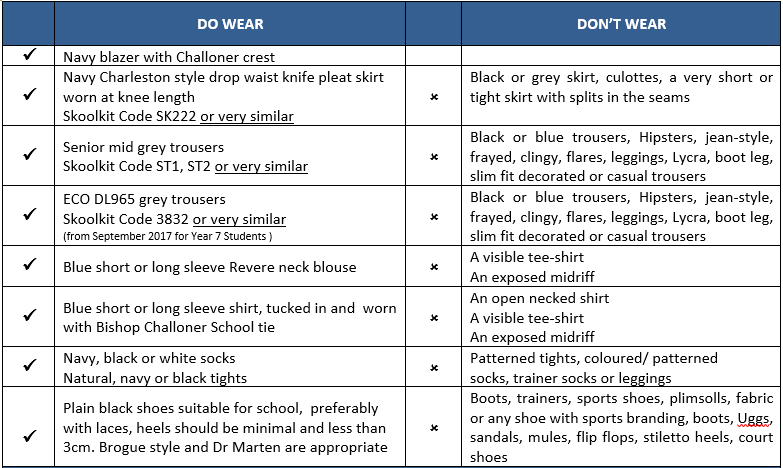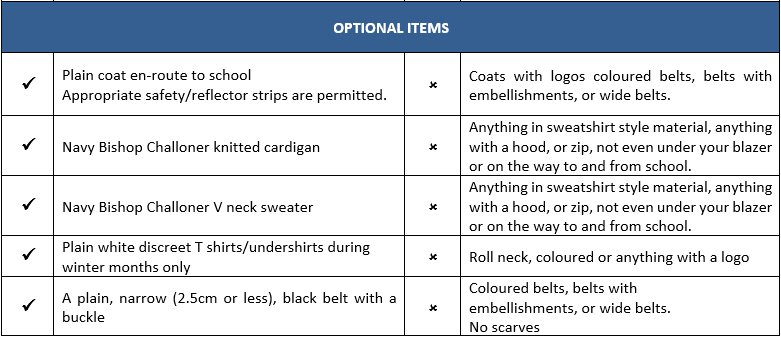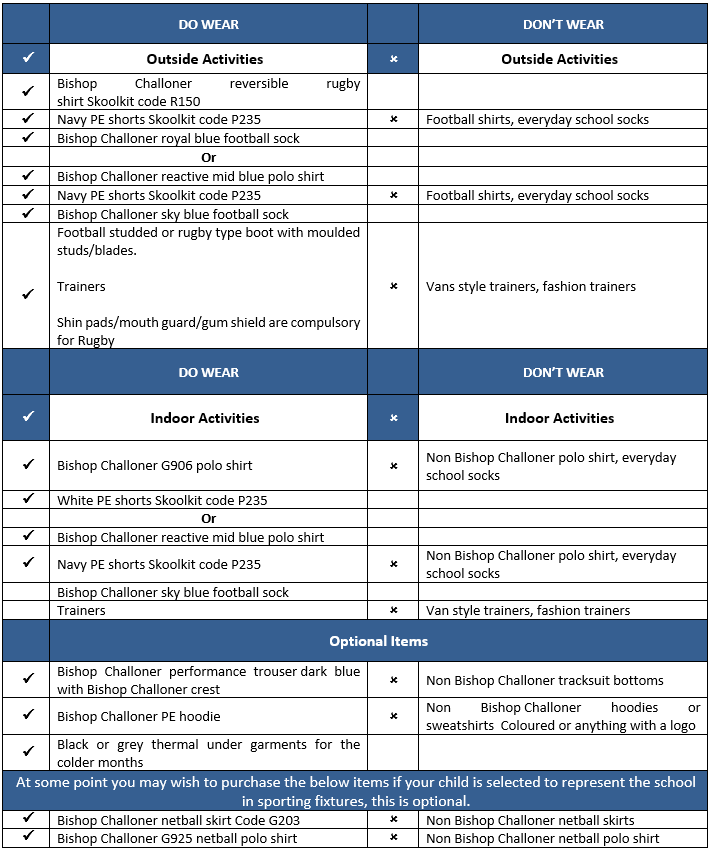 Uniform
Uniform
A condition of admission is the acceptance and upholding of the Governors’ uniform regulations. We expect all students to wear correct uniform at school and at any events where they may be representing the school; this includes the journey to and from school. Uniform is important in making all students equal by removing any pressure to dress in a certain way. It helps create inclusivity, so that no student feels excluded due to different social, religious or ethnic backgrounds. It also helps keep students safe and secure in school and on their way to and from school. Wearing a uniform identifies a student as being part of our school community and we expect students to wear this with pride. It also helps the transition to work where many occupations expect high standards of personal presentation.
Our uniform list is straightforward and reasonable. If you are uncertain about any items before purchase, please contact the School Office who will advise you.
Unless otherwise stated, all items of uniform are available from:
SKOOLKIT
15 CHURCH STREET
BASINGSTOKE
Please note the following:
- Styles, colours and materials must be as described on the following list. Smart appearance is required at all times.
- The wearing of the school blazer is compulsory for all students. Students are not allowed to wear any other jacket as an alternative. Outdoor coats may be worn over blazers during cold or rainy weather but not within the school building.
- Students who do not follow the uniform requirements may be placed in isolation or sent home.
- If your child is to be excused from PE for health reasons they are still required to change into their PE kit, this is to enable them to be identifiable within their group, and if there is inclement weather that they have dry uniform to change into.


PE Uniform

Make-Up (Years 7-10) Make-up, hair and jewellery
In the same way that the school has a clear uniform policy, the school also has specific rules regarding the wearing of make-up, nail varnish and nail extensions, hair and jewellery.
We want students to focus on their learning, and to get on well with others in their classes and at social times. We do not want to encourage an environment where students are competing in terms of their appearance or how “fashionable” they look.
Make-up is not permitted in Years 7-10. It is not deemed appropriate or necessary for students aged 11-15 to wear make-up in the school work environment for the reasons stated above. We also know that make-up could provide a distraction during lesson time given that younger students may be tempted to remove items from their bags to ‘top up’ or ‘reapply’. This would affect the learning and concentration of others.
As make-up is not permitted, tutors are provided with make-up wipes and will ask students in Years 7-10 to remove make-up during tutor time. Students will be sent to the Head of Year or School Office at other times of the day if they are found to be wearing make-up. If make-up is applied during the day, other sanctions may apply such as detentions. For repeated offences, this will be treated as defiance and the appropriate disciplinary measures taken. The use of make-up in school will be recorded on the school uniform card and the usual sanctions will apply.
If students are found to have items of make-up in their bags or on their person, the Year Team will remove these so that students are not tempted to use the items during the school day. These may be kept until the end of the day or until the end of the week (depending on the individual case).
Make-Up (Year 11)
Following a request from school council Year 11 students may apply ‘light touch’ make-up if they wish to do so. This means Year 11 students can wear make-up that is not noticeable to the observer e.g. light foundation, light mascara, clear lip balm. No other product should be used. This concession is to recognise them as senior students in the school and to support the transition to post 16 education or work. However, where a student abuses this privilege and wears too much make-up, then sanctions will follow and the student’s concession will be withdrawn.
Nail Varnish and Nail Extensions
Students will often say that nail varnish is a way to express individuality and/or enhance the attractiveness of their hands. Many would like to wear bright garish colours as fashions change.
This is, like eye-catching make-up, not appropriate for the working environment in school. We do not want to encourage an environment where students are competing in terms of their appearance or how “fashionable” they look.
In addition, we are aware that nail varnish or extensions can pose risks for students undertaking practical work in certain subjects.
Students wearing nail varnish/extensions involved in food preparation and cooking in technology lessons can (especially when inexperienced and learning “how to”), contaminate food with chippings of nail varnish or parts of nail extensions. Long false nails or extensions can be trapped or ripped moving round the school through doors and corridors, causing considerable pain and upset. They can cause harm to others in for example, PE games or drama practical work. These are situations which are easily avoided.
If a student comes to school wearing nail varnish, they will be asked by their tutor or their Head of Year to remove it immediately with nail polish remover. This will be entered onto the uniform card and normal sanctions will apply. If a student comes to school with nail extensions, they will be isolated during break and lunch time to minimize risk until the extensions are removed or cut down.
Hair
In the spirit of our approach to uniform, we also have simple rules around hairstyles to ensure that our working atmosphere is productive and focused on learning. Therefore, we have the following simple rules:
- Extremes of hairstyles are not permitted
- No lines or patterns should be cut into hair
- Hair dye, where used, should be appropriate to the natural colour. Highlights, “dipped” ends etc. are not appropriate
Jewellery
We ask that students do not wear jewellery to school. The only exceptions are:
- A small cross or recognised symbol of faith worn discreetly around the neck/wrist; one only
- One small stud per ear, in lobe only; no other piercings
- A watch (time telling only, not “smart”)
Students will be asked to remove any jewellery that does not conform to the above and uniform cards will be filled in to register this. The normal policy for uniform cards will then apply. Students who persistently wear jewellery inappropriately may have this confiscated. A parent will then have to collect this from the School Office.
Parents should check that students are not wearing any inappropriate jewellery before they leave for school.
Other
Mobile Phones
Mobile Phones are not to be used during school, this includes before school and during after school activities. Every student is assigned a personal Yondr Pouch. While the Yondr Pouch is considered school property, it is each student’s responsibility to bring their Pouch with them to school every day and keep it in good working condition.
DAILY PROCESS
As students Arrive to School, they will:
- Turn their mobile phone off.
- Open their Yondr Pouch by tapping against the Unlocking Base.
- Place their mobile phone inside the Pouch and secure it in front of school staff.
- Store it in their school bag for the day.
At the end of the day, students will open their Pouch, remove their mobile phone, close their Pouch and put it in their school bag.
Headphones
Headphones are not allowed to be worn or be visible in school.
Tattoos
It is a criminal offence to tattoo anyone under 18 unless a qualified medical practitioner does it for medical reasons. Any incidences of tattoos will be investigated by the school as an issue of child protection.
Staff decisions concerning aspects of uniform, hair or jewellery are final and non-negotiable. Please support our school policies by ensuring that your child follows these simple rules.
 Uniform
Uniform